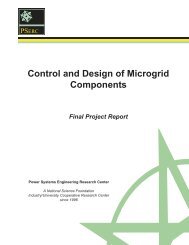Thrive: The Skills Imperative - Power Systems Engineering ...
Thrive: The Skills Imperative - Power Systems Engineering ...
Thrive: The Skills Imperative - Power Systems Engineering ...
Create successful ePaper yourself
Turn your PDF publications into a flip-book with our unique Google optimized e-Paper software.
27<br />
<strong>The</strong> principles of service science remain nascent.<br />
But the country that masters this discipline—and<br />
produces a cadre of service scientists and engineers<br />
who are able to accelerate innovation and productivity<br />
in service industries—has a clear advantage<br />
in attracting high-value service investments and<br />
creating high-value service jobs. <strong>The</strong> Japanese were<br />
the first to master product quality, but so far, no<br />
nation has mastered service science, management<br />
and engineering.<br />
Leverage Leadership in<br />
Computational Technologies<br />
Ongoing research at the Council on Competitiveness<br />
is demonstrating that, in the 21st century, “to<br />
outcompute is to outcompete.” America clearly has<br />
the technological edge. <strong>The</strong> most powerful computing<br />
systems in the world are in the United States, but<br />
America lacks sufficient numbers of computational<br />
scientists to exploit its leadership position. According<br />
to Council surveys, the biggest single constraint<br />
on the deployment of advanced computation tools is<br />
the lack of computational scientists.<br />
At the frontiers of science and engineering, advanced<br />
computation has become a major element of<br />
the third leg of discovery tools—the other two legs<br />
being theory and experimentation. Computer modeling<br />
and simulation dramatically accelerate the pace<br />
of innovation—and enable new-to-the-world knowledge<br />
and insights.<br />
But the business benefits of advanced computing<br />
are also becoming clear to the minority of companies<br />
that are able to use it. Leading companies are<br />
proving out the advantages of leveraging computational<br />
capabilities: accelerating design and engineering<br />
of new products; reducing time to market<br />
through virtual prototyping; and increasing supply<br />
chain efficiency and flexibility.<br />
Consider that:<br />
• In 1980, Boeing tested 77 wings in wind tunnels<br />
for the 767. Thanks primarily to high performance<br />
computing (HPC) simulation, Boeing needed<br />
to physically test only 11 wings for the 787<br />
Dreamliner series, dramatically cutting costs<br />
and design time.<br />
• Entertainment leader DreamWorks Animation<br />
SKG would not even exist without powerful<br />
computer graphics technology. Every movie is<br />
generated on a HPC system.<br />
• At <strong>The</strong> Proctor & Gamble Company, computational<br />
analysis is used for everything from increasing<br />
absorbency in Pampers ® diapers to designing the<br />
right geometric shape for Pringles ® potato chips—<br />
one that allows the chip to drop gently into a container<br />
rather than flying off the conveyor belt. 39<br />
• Wal-Mart optimizes its entire supply chain on<br />
computer models, including daily data analysis<br />
to determine what to stock in every store<br />
worldwide. 40<br />
• On any given day at the NASDAQ Exchange,<br />
more than two billion transactions are processed<br />
at rates of more than 200,000 transactions per<br />
second. <strong>The</strong> secret sauce is the ability to use<br />
computer modeling to increase volume and transaction<br />
speed reliably. 41<br />
America’s innovation advantage rests not just on<br />
having the most advanced tools and technologies in<br />
the world, but the people to use them.<br />
Bottom Line<br />
<strong>The</strong> world is being rewritten in digital, atomic and<br />
genetic codes. Information technologies, nanotechnologies<br />
and biotechnologies all hold out<br />
the promise that new ideas, inventions and innovations<br />
will ultimately create whole new industries,<br />
not yet conceived. America’s innovation<br />
advantage means continuous innovation in scientific<br />
talent as well as technology and creating<br />
the competitive difference that will concentrate<br />
cutting-edge investments in this country.
















